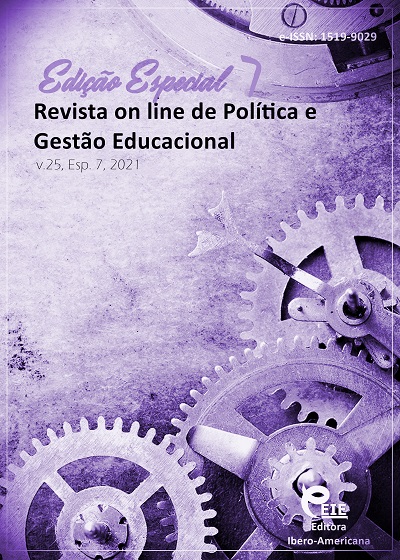Students’ opinions on online mathematics education, suggestions about improving the quality of education during the Covid-19 pandemic
DOI:
https://doi.org/10.22633/rpge.v25iesp.7.17389Keywords:
Distance education, Mathematics education, Student, Use of technology, Views on online educationAbstract
The study aims to determine the students' views on teaching mathematics online and get their suggestions for improvement. The participants were 125 students who study at 25 different departments from different faculties at a private university during the academic year of 2020-2021. The quantitative-qualitative mixed pattern model is utilised in the research. An online form was created in Google Forms and sent to students. In this form, there were some questions regarding their sex, age, departments that they studied in high school, departments they currently enrolled in, and 10 questions related to the research. Participants made many positive and negative opinions about online mathematics education. The answers given by the participants to the questions were examined in separate tables and analyzed according to the departments they graduated from high school (numerical and verbal weighted).
Downloads
References
AKDEMIR, Ö.; BIÇER, D.; PARMAKSIZ, R. Ş. Information and Communications Technology Metaphors. Mediterranean Journal of Social & Behavioral Research, v. 4, n. 1, p. 11-18, 2020. DOI: 10.30935/mjosbr/9596.
ALMANTHARI, A.; MAULINA, S.; BRUCE, S. Secondary school mathematics teachers’ views on E-learning implementation barriers during the COVID-19 pandemic: the case of Indonesia. Eurasia Journal of Mathematics, Science and Technology Education, v. 16, n. 7, em1860, 2020. DOI: .10.29333/ejmste/8240.
CALDWELL, E. R. A comparative study of three instructional modalities in a computer programming course: Traditional instruction, web-based instruction, and online instruction. The University of North Carolina at Greensboro, 2006.
CANDARLI, D.; YUKSEL, H. G. Students’ perceptions of video-conferencing in the classrooms in higher education. Procedia-Social and Behavioral Sciences, v. 47, p. 357-361, 2012.
CHEN, T. et al. Analysis of user satisfaction with online education platforms in China during the COVID-19 pandemic. Healthcare, v. 8, n. 3, p. 200, 2020. DOI: 10.3390/healthcare8030200.
CHIU, T. K. Applying the self-determination theory (SDT) to explain student engagement in online learning during the COVID-19 pandemic. Journal of Research on Technology in Education, p. 1-17, 2021. DOI: 10.1080/15391523.2021.1891998.
DE OLIVEIRA, M. M. S.; PENEDO, A. S. T.; PEREIRA, V. S. Distance education: advantages and disadvantages of the point of view of education and society. Dialogia, n. 29, p. 139-152, 2018.
GALLIGAN, L. et al. The use of tablet and related. 2010.
GÜRER, M.; TEKINARSLAN, E.; YAVUZALP, N. Opinions of instructors who give lectures online about distance education. Turkish Online Journal of Qualitative Inquiry, v. 7, n. 1, p. 47-78, 2016.
INAN, F. et al. The impact of self-regulation strategies on student success and satisfaction in an online course. International Journal on E-learning, v. 16, n. 1, p. 23-32, 2017.
JONES, D. Computing by distance education: Problems and solutions. ACM SIGCSE Bulletin, v. 28, n. SI, p. 139-146, 1996.
LEE, Y.; CHOI, J. A review of online course dropout research: Implications for practice and future research. Educational Technology Research and Development, v. 59, n. 5, p. 593-618, 2011.
PAPADOPOULOS, P. M. et al. The value of writing-to-learn when using question prompts to support web-based learning in ill-structured domains. Educational Technology Research and Development, v. 59, n. 1, p. 71-90, 2011.
SARIKAYA, H.; YARIMSAKALLI, M. S. The students’ view for teaching numerical analysis in the form of distance education. World Journal on Educational Technology: Current Issues, v. 12, n. 4, p. 348-360, 2020.
SILVERMAN, D.; DATA, I. Q. Methods for analysing talk, text and interaction. 2001.
TAMAH, S. M.; TRIWIDAYATI, K. R.; UTAMI, T. S. D. Secondary school language teachers’ online learning engagement during the COVID-19 pandemic in Indonesia. Journal of Information Technology Education: Research, v. 19, p. 803-832, 2020. DOI: 10.28945/4626.
TONBULOĞLU, B.; GÜROL, A. Analysis of distance education students’opinions and satisfaction levels of their programs. European Journal of Open Education and E-learning Studies, 2016.
Published
How to Cite
Issue
Section
License
Copyright (c) 2021 Revista on line de Política e Gestão Educacional

This work is licensed under a Creative Commons Attribution-NonCommercial-ShareAlike 4.0 International License.
Manuscritos aceitos e publicados são de propriedade da Revista on line de Política e Gestão Educacional. É vedada a submissão integral ou parcial do manuscrito a qualquer outro periódico. A responsabilidade do conteúdo dos artigos é exclusiva dos autores. É vedada a tradução para outro idioma sem a autorização escrita do Editor ouvida a Comissão Editorial Científica.











